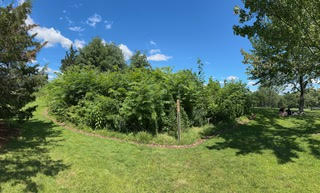Suzanne Simard’s book “Finding the Mother Tree” is a must-read for this Arbor Day (April 26) because you will forever view trees differently. Her pioneering work focused on communication between trees. Trees communicate via vast below-ground mycorrhizal fungal networks. She also discovered mother trees, or hub trees. These trees are the central hubs for the fungal networks and are usually the largest tree in the forest. The mother tree hypothesis predicts that seedling abundance and growth should be higher within the zone of active roots and mycorrhizal fungi of larger trees than outside this zone. In other words, the mothers care for their young.
When I look at trees in my own city and in other urban areas, I wonder if they have vast mycorrhizal networks. Can they communicate with other trees? What is the threshold number of trees to be able to communicate? I don’t know the answer to these questions but I am inclined to think that since most trees live with other trees, shrubs, and associated assemblages of plants such as in an Oak Woodland or a Redwood Forest, they must not like living alone.
The Encyclopedia Britannica defines a forest as a complex ecological system in which trees are the dominant life-form. It is also considered to be nature’s most efficient ecosystem, with a high rate of photosynthesis affecting both plant and animal systems in a series of complex organic relationships.
Which brings me to the concept of a micro-forest and why the idea appeals to me. A micro-forest (aka Miyawaki forests, mini-forests, or pocket forests) is a system of trees and plants that store carbon efficiently and requires little human maintenance after the first three years. They are of course not the same as a natural forest, nor can they replace one, but they do provide an opportunity to create a thriving ecosystem in an urban area.
As their name states they are small dense woods (can be as small as 10 feet by 10 feet) created in a comparatively short period of time based on careful selection of the plants that are best suited to the local environment.
Microforests can serve as noise buffers, help restore ecosystems, and absorb carbon. They are also good for buffering against extreme heat, polluted air, flooding and drought and provide an educational opportunity to connect people to nature and be part of a solution addressing the global climate emergency.
How a micro-forest could benefit Piedmont
Piedmont is making great strides by building an all electric pool, carrying out and updating the GHG Inventory, implementing the Climate Action Plan, offering electrification rebates, composting, and implementing/updating REACH codes.
We are a ‘tree city’ — we celebrate our Heritage Trees and Arbor Day and Piedmont’s Public Works Department and Parks Commission cares for over 12,000 trees and many beautiful gardens.
But with all of these efforts, we are still not reducing carbon emissions significantly and additional actions are needed. We can do more and one relatively easy approach would be to plant a micro-forest.
